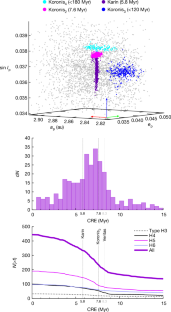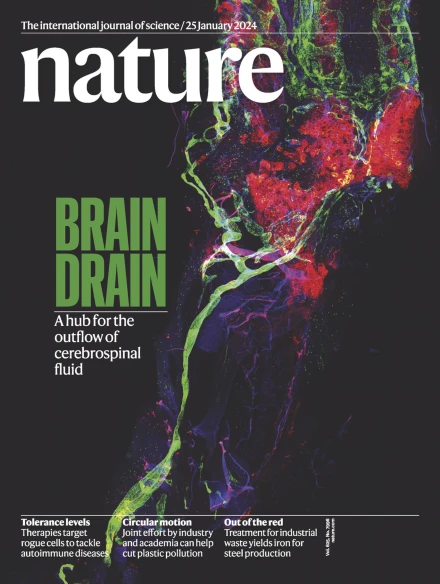Young asteroid families as the primary source of meteorites
IF 50.5
1区 综合性期刊
Q1 MULTIDISCIPLINARY SCIENCES
引用次数: 0
Abstract
Understanding the origin of bright shooting stars and their meteorite samples is among the most ancient of astronomy-related questions, which at larger scales has human consequences1–3. As of today, only approximately 6% of meteorite falls have been firmly linked to their sources (Moon, Mars or asteroid (4) Vesta4–6). Here we show that approximately 70% of meteorites originate from three recent break-ups of D > 30 km asteroids that occurred 5.8, 7.6 and less than about 40 Myr ago. These break-ups, including the well-known Karin family7, took place in the prominent yet old Koronis and Massalia families and are at the origin of the dominance of H and L ordinary chondrites among meteorite falls. These young families are distinguished among all main belt asteroids by having a uniquely high abundance of small fragments. Their size–frequency distribution remained steep for a few tens of millions of years, exceeding temporarily the production of metre-sized fragments by the largest old asteroid families (for example, Flora and Vesta). Supporting evidence includes the existence of associated dust bands8–10, the cosmic-ray exposure ages of H-chondrite meteorites11,12 and the distribution of the pre-atmospheric orbits of meteorites13–15. Three relatively recent break-up events relating to young asteroid families are probably the dominant sources of the current influx of meteoritic material to the Earth.

年轻小行星家族是陨石的主要来源
了解明亮流星及其陨石样本的起源是最古老的天文学相关问题之一,在更大范围内对人类有影响1,2,3。到目前为止,只有大约 6% 的陨石坠落与其来源(月球、火星或小行星 (4) 灶神星4,5,6)有明确的联系。在这里,我们展示了大约 70% 的陨石来源于最近发生在 5.8、7.6 和不到 40 Myr 前的三次 D > 30 km 小行星的分裂。这些碎裂,包括著名的卡林家族7,发生在著名而古老的科罗尼斯和马萨利亚家族中,是 H 和 L 普通软玉在陨石坠落中占主导地位的起源。在所有主带小行星中,这些年轻的家族因其独一无二的大量小碎片而与众不同。它们的大小-频率分布在几千万年内保持陡峭,暂时超过了最大的古老小行星家族(例如弗洛拉和灶神星)产生的米级碎片。佐证包括相关尘带的存在8,9,10 ,H-软玉陨石的宇宙射线暴露年龄11,12 以及陨石大气层前轨道的分布13,14,15。
本文章由计算机程序翻译,如有差异,请以英文原文为准。
求助全文
约1分钟内获得全文
求助全文
来源期刊

Nature
综合性期刊-综合性期刊
CiteScore
90.00
自引率
1.20%
发文量
3652
审稿时长
3 months
期刊介绍:
Nature is a prestigious international journal that publishes peer-reviewed research in various scientific and technological fields. The selection of articles is based on criteria such as originality, importance, interdisciplinary relevance, timeliness, accessibility, elegance, and surprising conclusions. In addition to showcasing significant scientific advances, Nature delivers rapid, authoritative, insightful news, and interpretation of current and upcoming trends impacting science, scientists, and the broader public. The journal serves a dual purpose: firstly, to promptly share noteworthy scientific advances and foster discussions among scientists, and secondly, to ensure the swift dissemination of scientific results globally, emphasizing their significance for knowledge, culture, and daily life.
 求助内容:
求助内容: 应助结果提醒方式:
应助结果提醒方式:


